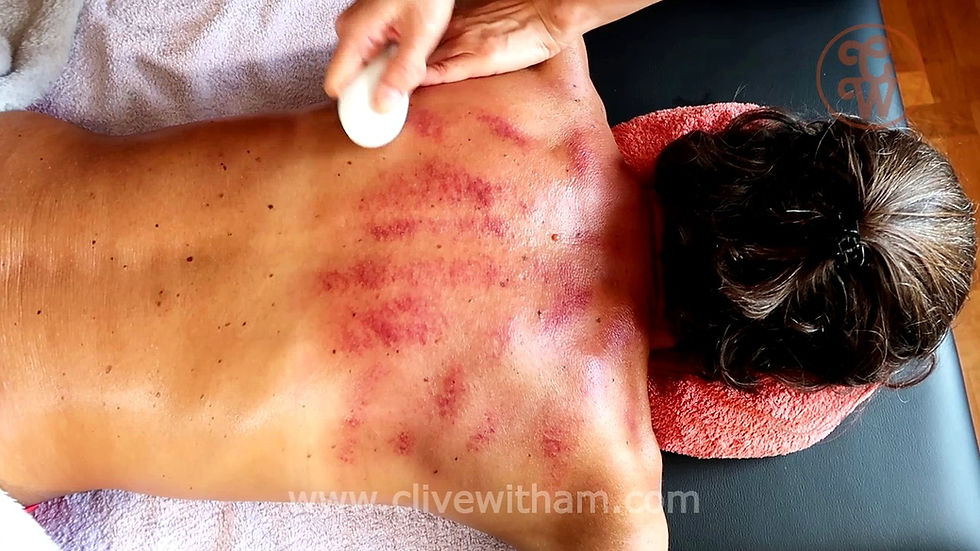Understanding Gua sha: A Comprehensive FAQ Guide | Clive Witham
- Clive
- Aug 5, 2020
- 3 min read
Updated: Oct 10, 2023

When used properly, Gua Sha can not only save you and your family a lot of medical expenses, but it can also strengthen your body and make it less susceptible to ill health.
Here is a FAQ of common Gua sha questions and misconceptions:
1. Is "Sha" necessary for Gua sha to be effective?
Sha is referring to a certain condition within the tissue which is blocking the movement of blood in that area. It is there because some faulty protective system has allowed it to get in your body and lodge itself in a place it shouldn't be. This is the case for colds, heatstroke, chest infections, the flu, stomach upsets and often muscle aches. For this type of problem, it is recommended that the red dots of sha come out on the skin and is a sign that the block is starting to move out of the body. If sha doesn't come out in a situation like this then it may mean that the health problem is caused by other reasons.
An important not is that the intensity of the scraping force should be adapted according to the physical condition of the person being scraped. People who are generally weak should not be strongly scraped. Light scraping should be enough to reveal the sha on the skin.
There are other situation whereby sha is just not wanted. Gua Sha on the face and that which is used for beauty and health care, the whole idea is to NOT have sha appear! Instead, you should gently scrape to promote blood circulation and reduce edema.
2. The Color of "Sha": Does Darker Mean Better?
You don't have to look like a boxer after a boxing bout. Nor like you've just survived a rather nasty accident. There is also a common idea that you need to suffer when it hurts with the patient grimacing in pain. Images and videos of this type are endless on the internet but this doesn't mean that they are necessarily correct in what they are doing.
Pain comes when there is a block and if you treat directly at the pain, not only might it be too uncomfortable but it might not be the place which is causing the block! If the sha color is dark, it means the problem is deeper and more chronic. If the problem isn't deep or chronic it won't go dark. For most people the sha will be a reddish or light purple-red color.
If you scrape too much, there is a danger in hurting the receiver and even causing physical damage. An 2018 example of this enthusiastic scraping is what happened to Mr. Zhang in Taichung city in Taiwan who, after intensively using Gua sha on his inner thighs, caused a bacterial infection and ended up at the ER at with necrotizing fasciitis.
3. Post-Treatment Care: What To Do After Gua sha Treatment?
What generally happens after Gua sha treatment is that the body sweats and it is important to be aware that you need to protect the area from aspects of the weather e.g. keep the area warm and dry, avoid being directly in the wind, It is also a good idea to rest for a while afterwards (up to 20 minutes) and avoid a cold shower for a few hours.
Depending on what kind of Gua sha treatment was given, it can be a good idea to drink warm water, tea, warm ginger soup, etc. to warm the body. Avoid drinking ice water even when the temperature is hot.
4. Post-Treatment Sensations: Is It Supposed To Hurt After Gua sha?
No, for many people, there is no feeling of discomfort. For some, there may be soreness within 24 hours of treatment depending on the treatment and within 2 to 3 days after scraping, there may be itching, pins and needles, chills, fever, or uneven rash changes.
There may also be internal changes resulting in changed bowel habits such as diarrhea.
5. Treatment Efficacy: What If Symptoms Don't Change After Several Gua sha Treatments?
If after several Gua sha treatments, the condition does not alleviate or even worsens, then further investigations are needed and perhaps other treatment methods. Gua sha, like all therapeutic techniques, isn't a one size fits all wonder treatment. It is a specific treatment for specific disorders in the body and if, for example, the problem lies on a deep level in the body, it may be more appropriate for another health modality to fix the problem.
✨ If you're ready to explore the potential of Ecology in Motion™ Gua sha, both personally and professionally, join me on this transformative journey of health and healing at the Komorebi Institute
.png)
.png)




















Comments